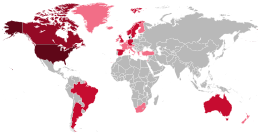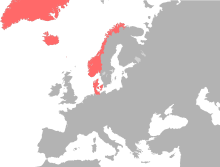
Demographic features of the population of Denmark proper, part of the Danish Realm, include ethnicity, education level, health of the populace, economic status, religious affiliations, and other aspects.

Nuuk is the capital of and most populous city in Greenland, an autonomous territory in the Kingdom of Denmark. Nuuk is the seat of government and the territory's largest cultural and economic center. Nuuk is also the seat of government for the Sermersooq municipality. In January 2024, it had a population of 19,872, – more than a third of the territory's population – making it one of the smallest capital cities in the world by population. Nuuk is considered a modernized city.
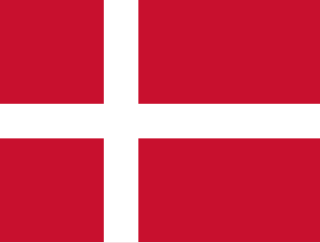
Denmark is a Nordic country in Northern Europe. It is the metropole and most populous constituent of the Kingdom of Denmark, also known as the Danish Realm, a constitutionally unitary state that includes the autonomous territories of the Faroe Islands and Greenland in the north Atlantic Ocean. Metropolitan Denmark, also called "continental Denmark" or "Denmark proper", consists of the northern Jutland peninsula and an archipelago of 406 islands. It is the southernmost of the Scandinavian countries, lying southwest and south of Sweden, south of Norway, and north of Germany, with which it shares a short border. Denmark proper is situated between the North Sea to the west and the Baltic Sea to the east.
The German diaspora consists of German people and their descendants who live outside of Germany. The term is used in particular to refer to the aspects of migration of German speakers from Central Europe to different countries around the world. This definition describes the "German" term as a sociolinguistic group as opposed to the national one since the emigrant groups came from different regions with diverse cultural practices and different varieties of German. For instance, the Alsatians and Hessians were often simply called "Germans" once they set foot in their new homelands.

The Danish ethnic minority in Southern Schleswig, Germany, has existed by this name since 1920, when the Schleswig Plebiscite split German-ruled Schleswig into two parts: Northern Schleswig with a Danish majority and a German minority was united with Denmark, while Southern Schleswig remained a part of Germany and had a German majority and Danish and Frisian minority populations. Their historic roots go back to the beginning of Danish settlement after the emigration of the Angles. One of the most common names they use to describe themselves is danske sydslesvigere.

Danish overseas colonies and Dano-Norwegian colonies were the colonies that Denmark–Norway possessed from 1537 until 1953. At its apex, the colonies spanned four continents: Africa, Asia, Europe, and North America.
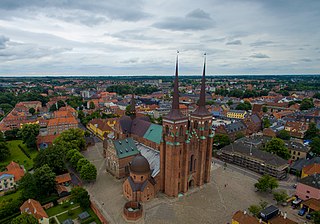
Christianity is the largest religion in Denmark. As of 2024, 71.2% of the population of Denmark were registered members of the Church of Denmark, the officially established church, which is Protestant in classification and Lutheran in orientation.
Nordic and Scandinavian Americans are Americans of Scandinavian and/or Nordic ancestry, including Danish Americans, Faroese Americans, Finnish Americans, Greenlandic Americans, Icelandic Americans, Norwegian Americans, and Swedish Americans. Also included are persons who reported 'Scandinavian' ancestry on their census. According to 2021 census estimates, there are approximately 9,365,489 people of Scandinavian ancestry in the United States.

The history of Jews in Denmark goes back to the 1600s. Although there were very likely Jewish merchants, sailors, and among others, who entered Denmark during the Middle Ages, back in around the year 1000, when Denmark became the first Christian Kingdom until 1536, though no efforts were made to establish a Jewish community. At present, Jewish community of Denmark constitutes a small minority of about 6,000 persons within Danish society.
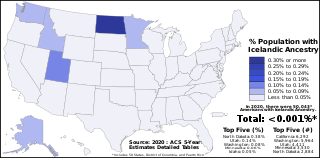
Icelandic Americans are Americans of Icelandic descent or Iceland-born people who reside in the United States. Icelandic immigrants came to the United States primarily in the period 1873–1905 and after World War II. There are more than 40,000 Icelandic Americans according to the 2000 U.S. census, and most live in the Upper Midwest. The United States is home to the second largest Icelandic diaspora community in the world after Canada.

The Kingdom of Denmark has only one official language, Danish, the national language of the Danish people, but there are several minority languages spoken, namely Faroese, German, and Greenlandic.
The Somali diaspora or Qurbajoogta refers to Somalis who were born in Greater Somalia and reside in areas of the world that they were not born in. The civil war in Somalia greatly increased the size of the Somali diaspora, as many Somalis moved from Greater Somalia primarily to Europe, North America, Oceania and South Africa. There are also small Somali populations in Asia. The UN estimates that in 2015, approximately 7 million people from Somalia were living outside of the country's borders.

The Danish Realm, officially the Kingdom of Denmark, or simply Denmark, is a sovereign state consisting of a collection of constituent territories united by the Constitutional Act, which applies to the entire territory. It consists of metropolitan Denmark—the kingdom's territory in continental Europe and sometimes called "Denmark proper" —and the realm's two autonomous regions: the Faroe Islands in the North Atlantic and Greenland in North America. The relationship between the three parts of the Kingdom is known as Rigsfællesskabet.
Danish Australians are Australians with full or partial Danish ancestry. The majority of these people are part of the Danish diaspora.
European Canadians are Canadians who can trace their ancestry to the continent of Europe. They form the largest panethnic group within Canada.
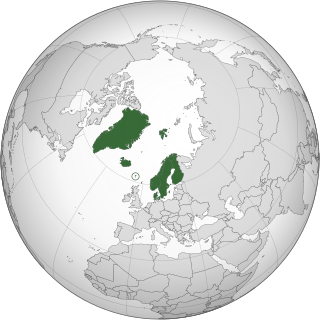
The Nordic countries are a geographical and cultural region in Northern Europe and the North Atlantic. It includes the sovereign states of Denmark, Finland, Iceland, Norway and Sweden; the autonomous territories of the Faroe Islands and Greenland; and the autonomous region of Åland.
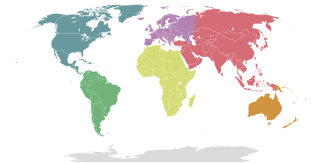
Christianity is a prevalent religion in Denmark; in January 2023, 72.1% of the population of Denmark were members of the Church of Denmark. According to a survey based on a sample 1,114, 25% of Danes believe Jesus is the son of God, and 18% believe he is the saviour of the world. Aside from Lutheranism, there is a small Catholic minority, as well as small Protestant denominations such as the Baptist Union of Denmark and the Reformed Synod of Denmark.

Danish Greenlanders are ethnic Danes residing in Greenland and their descendants.

Greenlandic people in Denmark are residents of Denmark with Greenlandic or Greenlandic Inuit heritage. According to StatBank Greenland, as of 2020, there were 16,780 people born in Greenland living in Denmark, a figure representing almost one third of the population of Greenland. According to a 2007 Danish government report, there were 18,563 Greenlandic people living in Denmark. The exact number is difficult to calculate because of the lack of differentiation between Greenlandic and Danish heritage in Danish government records and also due to the fact that the way in which people identify themselves is not always a reflection of their birthplace. As of 2018, there were 2,507 Greenlanders enrolled in education in Denmark.

Danish Argentines are Argentine citizens of Danish ancestry or people who have emigrated from Denmark and reside in Argentina. Danish immigration to Argentina was particularly intense between the late 19th century and early 20th century. It is estimated that between 1857 and 1930 about 18,000 Danes settled in Argentina. The wave of Danish immigration to Argentina was the third largest in the world, behind those in the United States and Australia, making it one of the largest Danish communities in the world. They also include Faroese and Greenlandic Argentines because of Faroe Islands' and Greenland's status as an autonomous territory of Denmark.
